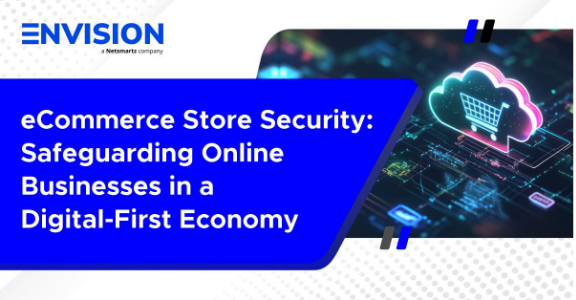eCommerce Store Security: Safeguarding Online Businesses in a Digital-First Economy
-
 Jess Mann
Jess Mann
- 1 month

In digital-first economy, an online store is more than a sales channel—it is the foundation of customer trust and sustainable growth. Yet with opportunity comes risk. As eCommerce expands, cybercriminals increasingly target online businesses. This makes eCommerce store security not just a technical priority, but a core business strategy.
This guide explains what eCommerce store security is, the most common cyber threats to online stores, and the best practices for eCommerce store security that B2B and B2C enterprises must follow to protect sensitive data and maintain long-term customer confidence.
What Is eCommerce Store Security?
eCommerce store security refers to the policies, technologies, and processes that ensure the integrity, confidentiality, and availability of online retail operations. It is designed to protect customer information, prevent fraud, and secure online transactions.
Key elements include:
- Encryption for eCommerce transactions to keep payment data safe.
- Password security and access control for administrators and users.
- Secure checkout processes to ensure customer trust.
- Malware protection for eCommerce to defend against hidden attacks.
- Two-factor authentication to reduce unauthorized access.
The importance of eCommerce store security goes beyond compliance. It directly influences brand reputation, conversion rates, and customer loyalty.
Also Read: How eCommerce Store Management Helps Online Stores
Cyber Threats to Online Stores
Digital storefronts face a wide spectrum of eCommerce store security issues. Some of the most common include:
1. DDoS Attacks – Malicious traffic floods a website, making it inaccessible for genuine users. Poor development practices can increase this risk, as highlighted in common eCommerce development mistakes.
2. SQL Injections – Hackers exploit database vulnerabilities to manipulate or extract sensitive information. Choosing a secure payment gateway can prevent many of these threats.
3. Malware Infections – Spyware, ransomware, or viruses can compromise customer data and disrupt operations.
4. Phishing Attempts – Fraudulent emails or links designed to steal login credentials or payment details.
5. Fake Orders & Payment Fraud – Fraudulent transactions that increase costs and reduce profitability.
Each of these online store vulnerabilities not only disrupts operations but erodes trust—a critical currency in eCommerce.
Best Practices for eCommerce Store Security
Organizations must adopt a layered approach to security features for eCommerce stores. Here are proven strategies:
1. Select a Secure eCommerce Platform
- Platforms should provide regular security patches and built-in compliance features.
- Ensure PCI DSS compliance for safe online payment processing.
- Choose a most secure eCommerce platform that scales with your business while ensuring stability.
2. Implement SSL Certificates for eCommerce
- An SSL certificate for eCommerce protects sensitive information by encrypting data transfers.
- Customers trust sites with HTTPS for eCommerce stores, and search engines prioritize them in rankings.
- A missing SSL often results in higher cart abandonment and lower customer confidence.
3. Adopt Firewalls and Malware Protection
- Web application firewalls (WAFs) block malicious traffic before it reaches your site, stopping common attacks like SQL injection and XSS at the edge.
- Enterprise-grade malware protection for eCommerce detects spyware, ransomware, and viruses early to prevent data theft and operational disruption.
- Reducing downtime and cleaning infections quickly protects customer trust and preserves your brand reputation.
4. Use Two-Factor Authentication
- Strengthen password security and access control by requiring multiple verification steps beyond just a password.
- Apply two-factor authentication (2FA) for both customers and employees to add a second layer of defense on sensitive accounts.
- 2FA mitigates the risks of brute-force attacks and compromised credentials, significantly reducing account takeover incidents.
5. Schedule Regular Backups and SQL Checks
- Conduct regular SQL vulnerability scans to identify misconfigurations, injection points, and other database weaknesses.
- Automate daily or weekly backups (and periodically test restores) to protect against accidental loss, corruption, or ransomware.
- A clear backup and recovery strategy ensures business continuity even if other security defenses are breached.
For ongoing support, consider eCommerce Store Management Services to keep your store secure and optimized.
How to Secure an Online Store and Prevent Fraud
Fraud prevention is as critical as technical security. Implementing the right measures helps protect revenue, maintain trust, and reduce risks from fraudulent activities.
- Transaction Monitoring to identify abnormal purchase patterns in real time and flag suspicious activity.
- Fake Orders Prevention by using verification protocols and validating bulk or high-value orders before processing.
- AI in eCommerce Security with machine learning tools that detect anomalies and stop fraudulent activity faster than manual reviews.
These measures form the backbone of eCommerce fraud prevention strategies for enterprises.
Mobile eCommerce Security: Protecting the Next Growth Engine
With mobile commerce now accounting for the majority of eCommerce transactions, mobile eCommerce security has become a non-negotiable priority for businesses looking to safeguard customer trust and maintain seamless operations.
- End-to-end encryption for all mobile transactions to secure sensitive data during transfers.
- Biometric authentication such as fingerprint or facial recognition to strengthen user identity verification.
- Regular app updates to patch vulnerabilities and prevent exploitation by attackers.
- Cloud-based eCommerce security to protect distributed mobile environments with scalable defenses.
Neglecting mobile channels leaves enterprises exposed to significant revenue and data risks.
Future Trends in eCommerce Security
The future of eCommerce security will be shaped by advanced technologies that enhance resilience, protect sensitive data, and outpace evolving cyber threats.
- AI-Powered Fraud Detection – to anticipate and block threats in real time with machine learning algorithms.
- Blockchain for Online Transaction Security – to enable tamper-proof, transparent, and verifiable payment systems.
- Zero-Trust Security Models – that validate every user, device, and transaction to minimize both internal and external risks.
- Quantum Encryption – to future-proof sensitive data against next-generation cyberattacks and quantum computing threats.
Forward-looking enterprises recognize that investing in these emerging security technologies ensures a secure eCommerce future.
Conclusion
The importance of eCommerce store security cannot be overstated. From SSL certificates and firewalls to two-factor authentication and fraud prevention, businesses must treat security as a foundation for sustainable growth.
By implementing the best practices for eCommerce store security, organizations can:
- Protect customer data online to safeguard sensitive information and prevent breaches.
- Ensure regulatory compliance by adhering to industry standards and data protection laws.
- Build and maintain customer trust through secure, reliable, and transparent online shopping experiences.
Enterprises that prioritize security measures for eCommerce stores not only safeguard digital assets but also gain a competitive advantage in a crowded market.
Frequently Asked Questions
- What are the main security issues of e-commerce?
- What are the most common eCommerce security threats?
- Why is eCommerce website security important?
- What are the best practices to secure my eCommerce website?
- How can I prevent online payment fraud?
- How do I protect customer data on my online store?
E-commerce websites face several security challenges that can impact both businesses and customers. Common issues include data breaches, payment fraud, malware attacks, and insecure third-party integrations. Weak encryption, outdated software, and poor compliance with security standards can make your store vulnerable to hackers, leading to financial loss and reputational damage.
The most frequent threats include credit card fraud, phishing scams, DDoS attacks, SQL injections, and account takeovers. These attacks can disrupt your operations, compromise sensitive data, and erode customer trust. Staying proactive with security measures is essential to prevent these risks.
Security is the backbone of any online business. It protects sensitive customer information, prevents financial losses, and builds trust with your audience. A secure website also ensures compliance with regulations like GDPR and PCI DSS, which are critical for avoiding legal penalties and maintaining your brand’s credibility.
Start with the basics: install SSL certificates, use strong passwords, enable two-factor authentication, and choose secure payment gateways. Regularly update your platform, plugins, and themes to patch vulnerabilities. Implement firewalls, schedule data backups, and monitor your site for suspicious activity to stay ahead of cyber threats.
Preventing payment fraud requires multiple layers of protection. Enable 3D Secure, use fraud detection tools, and verify transactions with CVV and AVS checks. Monitor unusual activity, set transaction limits, and work with PCI-compliant payment processors to ensure safe and secure transactions.
Protecting customer data starts with encryption for sensitive information and secure storage practices. Limit employee access to critical data, conduct regular security audits, and comply with privacy laws like GDPR. Transparency with your customers about how their data is used also builds confidence and trust.













